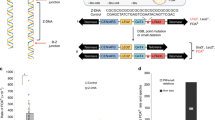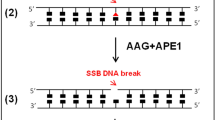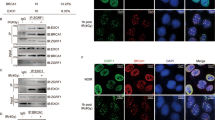Abstract
The tumor suppressor p53 plays an important role in response to DNA damage, including DNA repair. One DNA repair pathway, nucleotide excision repair (NER), has been well-documented to be regulated by p53. It seemed probable that p53 may affect other DNA repair pathways. We employed matched isogenic pairs of cell lines, wild-type or p53-deficient, to investigate this question using methyl methanesulfonate (MMS), a base-damaging agent. Alkylation damage induced by MMS is repaired exclusively by the base excision repair (BER) pathway. Cells carrying mutant or no p53 genes exhibited slow BER of MMS-induced DNA damage, and exhibited MMS-sensitivity. One contributing factor is the abundance of DNA polymerase β (β-pol), an enzyme required for BER, which was almost absent in p53 mutant and p53-null cells. Our findings demonstrate an in vivo requirement for p53 in regulating the base excision repair response, a novel finding of great potential importance in understanding the DNA repair branch of the p53 pathway.
This is a preview of subscription content, access via your institution
Access options
Subscribe to this journal
Receive 50 print issues and online access
$259.00 per year
only $5.18 per issue
Buy this article
- Purchase on Springer Link
- Instant access to full article PDF
Prices may be subject to local taxes which are calculated during checkout




Similar content being viewed by others
Abbreviations
- MMS:
-
methyl methanesulfonate
- BER:
-
base excision repair
- AP:
-
apurinic site
- APE:
-
apurinic/apyrimidinic endonuclease
- β-pol:
-
DNA-polymerase beta
References
Brown JM, Wouters BG . 1999 Cancer Res. 59: 1391–1399
Collins AR, Ma A-G, Duthie SJ . 1995 Mut. Res. 336: 69–77
Evans AR, Limp-Foster M, Kelley MR . 2000 Mutat Res. 461: 83–108
Fan S, Smith ML, Rivet DJ, Duba D, Zhan Q, Kohn KW, Fornace Jr AJ, O'Connor PM . 1995 Cancer Res. 55: 1649–1654
Ford JM, Hanawalt PC . 1995 Proc. Natl. Acad. Sci. USA 92: 8876–8880
Ford JM, Hanawalt PC . 1997 J. Biol. Chem. 272: 28073–28080
Fortini P, Pascucci B, Belisario F, Dogliotti E . 2000 Nucleic Acids Res. 28: 3040–3046
Friedberg EC, Walker GC, Seide W . 1995 DNA Repair and Mutagenesis ASM Press: Washington, D.C
Hawkins DS, Demers GW, Galloway DA . 1996 Cancer Res. 56: 892–898
Hollander MC, Anver M, Kim K, Fornace Jr AJ . 2001 Cancer Res. 61: 2487–2491
Hwang BJ, Ford JM, Hanawalt PC, Chu G . 1999 Proc. Natl. Acad. Sci. USA 96: 424–428
Jayaraman L, Murthy K, Zhu C, Curran T, Xanthoudakis S, Prives C . 1997 Genes Dev. 11: 558–570
Kastan MB, Zhan Q, el-Deiry WS, Carrier F, Jacks T, Walsh WV, Plunkett BS, Vogelstein B, Fornace Jr AJ . 1992 Cell 71: 587–597
Klungland A, Hoss M, Gunz D, Constantinou A, Clarkson SG, Doetsch PW, Bolton PH, Wood RD, Lindahl T . 1999 Mol. Cell 3: 33–42
Lackinger D, Kaina B . 2001 Mutat. Res. 457: 113–123
Leveillard T, Andera L, Bissonnette N, Schaffer L, Bracco L, Egly JM, Wasylyk B . 1996 EMBO J. 15: 1615–1624
Matsumoto Y, Kim K, Hurwitz J, Gary R, Levin DS, Tomkinson AE, Park MS . 1999 J. Biol. Chem. 274: 33703–33708
Morris EJ, Dreixler JC, Cheng CY, Wilson PM, Gin RM, Geller HM . 1998 Biotechniques 26: 282–289
Offer H, Zurer I, Banfalvi G, Reha'k M, Falcovitz A, Milyausky M, Goldfinger N, Rotter V . 2001a Cancer Res. 61: 88–96
Offer H, Milyavsky M, Erez N, Matas D, Zurer I, Harris CC, Rotter V . 2001b Oncogene 20: 581–589
Okorokov AL, Milner J . 1999 Mol. Cell. Biol. 19: 7501–7510
Seo YR, Chen E, Smith ML . 2001 Breast Cancer Res. Treat. in press
Smith ML, Chen IT, Zhan Q, O'Connor PM, Fornace Jr AJ . 1995 Oncogene 10: 1053–1059
Smith ML, Ford JM, Hollander MC, Bortnick RA, Amundson SA, Seo YR, Deng C, Hanawalt PC, Fornace Jr AJ . 2000 Mol. Cell. Biol. 20: 3705–3714
Sobol RW, Prasad R, Evenski A, Baker A, Yang XP, Horton JK, Wilson SH . 2000 Nature 405: 807–810
Stucki M, Pascucci B, Parlanti E, Fortini P, Wilson SH, Hubscher U, Dogliotti E . 1998 Oncogene 17: 835–843
Tokino T, Thiagalingam S, el-Deiry WS, Waldman T, Kinzler KW, Vogelstein B . 1994 Hum. Mol. Genet. 3: 1537–1542
Wilson SH, Kunkel TA . 2000 Nat. Struct. Biol. 7: 176–178
Zhou J, Ahn J, Wilson SH, Prives C . 2001 EMBO J. 20: 914–923
Acknowledgements
We thank David W O'Hannesian, Lindsey D Mayo, and two anonymous reviewers for their insightful comments on the manuscript. This work was supported by Indiana University Cancer Center and American Cancer Society grants 1RG84-002 and RSG-02-028-01-CNE (ML Smith).
Author information
Authors and Affiliations
Rights and permissions
About this article
Cite this article
Seo, Y., Fishel, M., Amundson, S. et al. Implication of p53 in base excision DNA repair: in vivo evidence. Oncogene 21, 731–737 (2002). https://doi.org/10.1038/sj.onc.1205129
Received:
Revised:
Accepted:
Published:
Issue Date:
DOI: https://doi.org/10.1038/sj.onc.1205129
Keywords
This article is cited by
-
The role of DNA damage responses in p53 biology
Archives of Toxicology (2015)
-
Unravelling mechanisms of p53-mediated tumour suppression
Nature Reviews Cancer (2014)
-
Isofraxidin, a potent reactive oxygen species (ROS) scavenger, protects human leukemia cells from radiation-induced apoptosis via ROS/mitochondria pathway in p53-independent manner
Apoptosis (2014)
-
The significance of the alteration of 8-OHdG in serous ovarian carcinoma
Journal of Ovarian Research (2013)
-
Monomeric but not trimeric clathrin heavy chain regulates p53-mediated transcription
Oncogene (2008)



